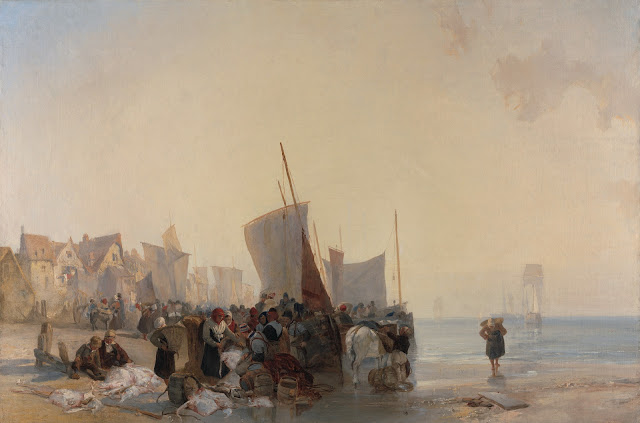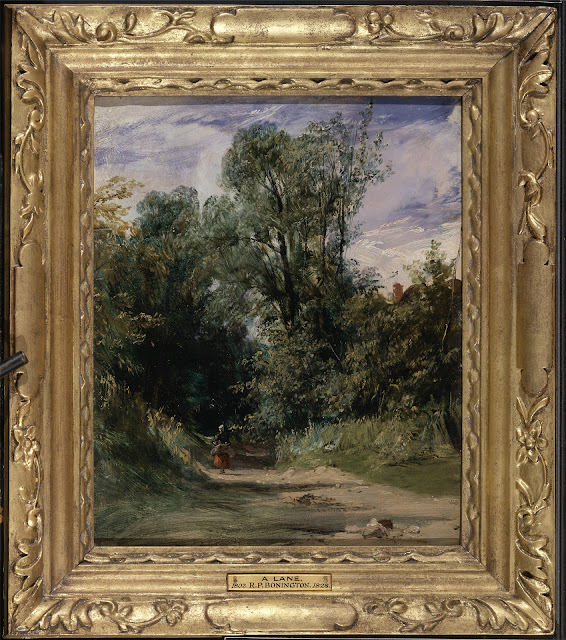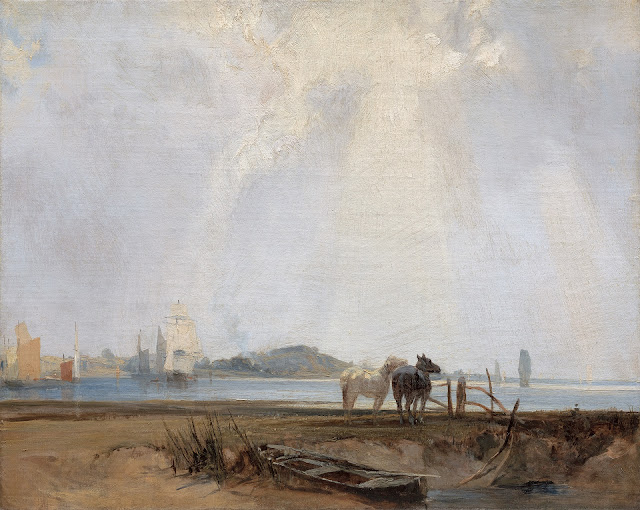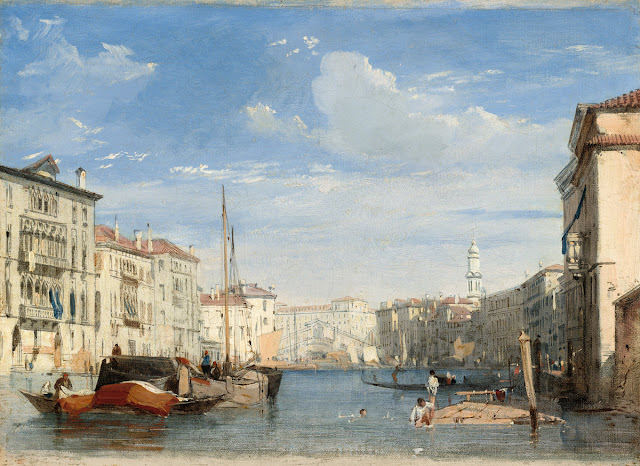 |
| Richard Parkes Bonington Distant view of St Omer ca. 1824 oil on canvas Tate Gallery |
"Bonington was born near Nottingham but moved to Calais in 1817 with his parents. There they set up a lace-making business before settling in Paris the following year. Most of his short life was spent in France. Delacroix was not alone in admiring his 'marvellous grasp of effects and the facility of his execution.' Working at first in watercolour, Bonington took up oils in 1823. He spent most of 1824 in Dunkerque and probably painted this view of St. Omer from the Boulogne-Calais road that year."
– curator's notes from the Tate Gallery, London
 |
| Richard Parkes Bonington Beached Vessels and Wagon near Trouville ca. 1825 oil on canvas Yale Center for British Art |
 |
| Richard Parkes Bonington Fish Market near Boulogne 1824 oil on canvas Yale Center for British Art |
 |
| Richard Parkes Bonington French Coast with Fishermen ca. 1825 oil on canvas Tate Gallery |
 |
| Richard Parkes Bonington In the Forest of Fontainebleau ca. 1825 oil on panel Yale Center for British Art |
 |
| Richard Parkes Bonington A Wooded Lane ca. 1825 oil on panel Yale Center for British Art |
 |
| Richard Parkes Bonington Roadside Halt 1826 oil on canvas Metropolitan Museum of Art, New York |
 |
| Richard Parkes Bonington La Ferté ca. 1825 oil on panel National Gallery, London |
"The site of this fresh and immediate sketch has been cautiously identified as that of La Ferté in the estuary of La Somme, on the Picardy coast. The north coast of France was frequently travelled by Bonington, and provided him with a wealth of subjects for his coast scenes. La Ferté and nearby St. Valéry-sur-Somme were among his favourite haunts and those of his painting companions, Paul Huet and Thomas Shotter Boys. This work is a study made on the spot. The whole is quickly and fluidly painted, with the stretches of sand, sea and sky painted with broad horizontal sweeps of the brush. Certain details, such as the boat on the left and the small boat to the right in the distance are painted wet-in-wet, but others, such as the boat on the right and the figure of the woman were likely to have been added in the studio."
– curator's notes from the National Gallery, London
 |
| Richard Parkes Bonington Near Quilleboeuf ca. 1824-25 oil on canvas Yale Center for British Art |
 |
| Richard Parkes Bonington Pont des Arts, Paris ca. 1826 oil on panel Tate Gallery |
"Bonington moved to Paris in 1818 but it appears to have been only towards the end of his life that he paid much attention to the city as a subject for his art. He is reported to have spent his last two months in Paris sketching scenes from a hired cab, perhaps in response to a commission to make drawings for a series of engraved views. This oil sketch of the Pont des Arts and the Ile de la Cité seen from the Quai du Louvre was probably painted a year or so earlier."
– curator's notes from the Tate Gallery, London
 |
| Richard Parkes Bonington View near Rouen ca. 1825 oil on panel Metropolitan Museum of Art, New York |
"Bonington's early preference for marine views was never entirely abandoned, and this landscape is atypical in its landlocked subject, and is also unusual in being a sketch laid in before the motif with broad ribbons and daubs of color. While the English-born Bonington was trained in France, the impetus for painting out of doors seems to have come from Constable, whose work he first saw at the Paris Salon of 1824 and came to know better while visiting London and its environs the following summer. In the present study, which may date to the late summer or autumn of 1825, the view is as found, rather than as composed, and is thus more in accordance with English than with French practice."
– curator's notes from the Metropolitan Museum of Art, New York
 |
| Richard Parkes Bonington Corso Sant'Anastasia, Verona 1828 oil on panel Yale Center for British Art |
 |
| Richard Parkes Bonington Grand Canal, Venice ca. 1826-27 oil on canvas National Gallery of Art, Washington DC |
"In the spring of 1826 Richard Parkes Bonington spent four weeks in Venice with his patron, Charles Rivet. . . . In addition to the numerous graphite drawings he made of picturesque views of Venice, he produced nearly thirty works in both watercolor and oil. Many of these were completed on-site, while others [such as this one] would become the basis for more complex pictures composed later in the studio. . . . Although his career was brief, Bonington had a reputation as a master of light and atmosphere, recognized not only by his contemporaries but by following generations as well. . . . His oeuvre is all the more remarkable when we remember that his considerable artistic output was produced in roughly ten years."
– curator's notes from the National Gallery of Art, Washington DC
 |
| Richard Parkes Bonington Ducal Palace with a Religious Procession, Venice ca. 1828 oil on canvas Tate Gallery |
 |
| Margaret Sarah Carpenter Portrait of Richard Parkes Bonington ca. 1827-30 oil on canvas National Portrait Gallery, London |